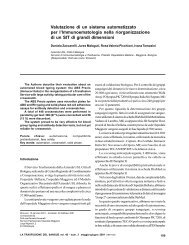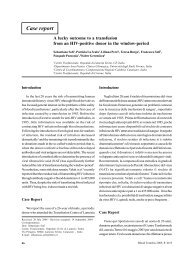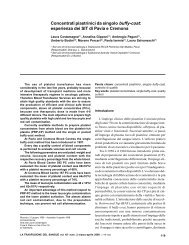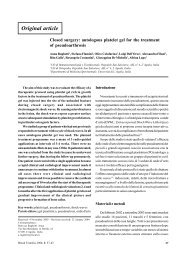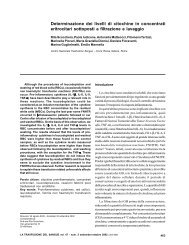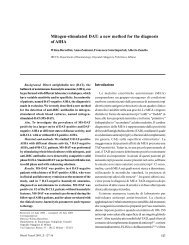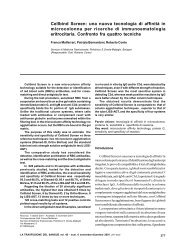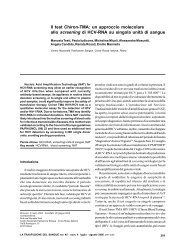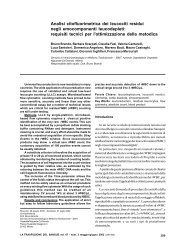Mathematics and transfusion medicine - Blood Transfusion
Mathematics and transfusion medicine - Blood Transfusion
Mathematics and transfusion medicine - Blood Transfusion
You also want an ePaper? Increase the reach of your titles
YUMPU automatically turns print PDFs into web optimized ePapers that Google loves.
Morelati F et al.Table I - Results of the identification of red cell antibodies carried out with a completely automated instrumentType of sample Complete agreement Additional antibodies Antibodies not detected by(n.) detected by the instrument (n.) the instrument (n.)Immunised subjects 91 11 samples 2 IgM antibodies12 antibodies* (anti-K, anti-M)Non-immunised subjects 61 0 0(*) 2 anti-c, 1 anti-E, 1 anti-Jk a , 1 anti-K, 1 anti-C w , 1 anti-N, 3 autoantibodies, 2 antibodies against low incidence antigensto <strong>transfusion</strong> of st<strong>and</strong>ard platelet concentrates' is one ofthe most important complications in subjects requiring<strong>transfusion</strong> support <strong>and</strong> indicates repeated, poorincrements in post-<strong>transfusion</strong> platelet count (threeconsecutive platelet counts below 5 x 10 9 /L). This condition,which can be associated with severe clinical complications,is caused by the presence of class I antibodies againsthuman leucocyte antigens (HLA) <strong>and</strong> is observed in 13-14% of patients with leukaemia transfused with st<strong>and</strong>ardblood components <strong>and</strong> in 3-4% of subjects transfused withleucocyte-depleted blood components. The traditional<strong>transfusion</strong> approach is based on choosing HLA identicalor compatible donors or on selecting appropriate donorsthrough tests of platelet compatibility. In our laboratorywe have chosen the latter approach by using the plateletconcentrates (from buffy-coats or obtained throughapheresis products) present in the daily inventory of theunits <strong>and</strong> a completely automated instrument based on thesolid-phase technology.Over a period of 33 months, post-<strong>transfusion</strong> plateletcount increments were evaluated in 40 refractory subjects(27 women, 13 men) transfused with platelet concentratesselected using this procedure 11,12 <strong>and</strong> the increments wererelated to known detrimental clinical factors <strong>and</strong> to the post<strong>transfusion</strong>increments (at 1 hour after the <strong>transfusion</strong>),observed after the last three <strong>transfusion</strong>s with st<strong>and</strong>ardplatelet concentrates (not selected by platelet cross-match).Within 48 hours from starting the selection procedure, thesubjects under consideration had been transfused with569 platelet concentrates (median value 8 concentrates/patient, containing 202 ± 71 x 10 9 platelets), obtained frombuffy-coats or by apheresis procedures. The median pre<strong>transfusion</strong>platelet count was 7.7 ± 5.5 10 9 /L <strong>and</strong> the post<strong>transfusion</strong>platelet increments exceeded 10,000 platelets/µL in 68% of the cases (Figure 1).The post-<strong>transfusion</strong> counts in subjects withdetrimental factors were lower (28.9 ± 20.3 x 10 3 platelets/µL at 1 hour after the end of the <strong>transfusion</strong>) than those60observed in subjects without such factors (35.9 ± 21.2 x10 3 platelets/µL at 1 hour after the end of the <strong>transfusion</strong>).The investigation of autoimmune haemolyticdisordersAmong the many red cell immunhaematology problems,one of the most difficult to manage is autoimmunehaemolytic disease with a negative direct antiglobulin test(DAT). In order to resolve the diagnostic problem in thesecases, a battery of investigations must be used, carried outwith different methods (agglutination tests, solid phasetests, ELISA, flow cytometry, immunoradiometric tests,evaluation of complement consumption). One particularlyuseful test in the study of these complications is the mitogenstimulation test (MS-DAT), designed by Barcellini 13, 14 <strong>and</strong>colleagues, which is used to evaluate the prevalence ofpositive results in subjects with autoimmune haemolyticanaemia (AIHA) in clinical remission or in an active phaseof the disease. The MS-DAT test is carried out bystimulating whole blood cultures from the investigatedsubjects with mitogen (phytohaemagglutinin – PHA;phorbol-12-myristate-13-acetate – PMA; or pokeweedmitogen-PWM); the production of antibodies in the cultureafter stimulation is evaluated by a competitive ELISA insolid phase. An agglutination DAT, using the st<strong>and</strong>ardtest-tube method, a DAT with red cells washed in low ionicstrength solution or cold physiological saline, <strong>and</strong> a solidphase test for immunoadherence were carried out in parallelin all subjects 4-6 . Using this technique, 33 subjects withAIHA were studied (of whom 27 in an active phase ofdisease with a positive DAT, <strong>and</strong> 6 subjects with previousAIHA who had become DAT negative) <strong>and</strong> 7 subjects withDAT-negative AIHA, whose disease had been diagnosedon the basis of exclusion of all other causes of haemolysis<strong>and</strong> on the response to steroid therapy. Furthermore, westudied 69 subjects with chronic B-cell lymphocyticleukaemia (B-CLL), a disease associated with a highprevalence of autoimmunity against red blood cells, with<strong>Blood</strong> Transfus 2007; 5: 58-65 DOI 10.2450/2007.0006-07058-65_Morelati.p65 6005/07/2007, 10.39



